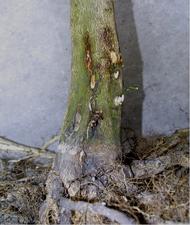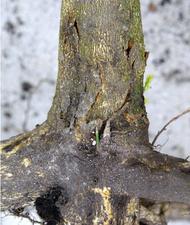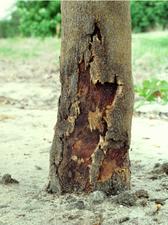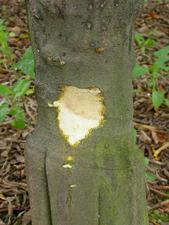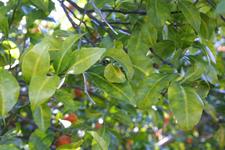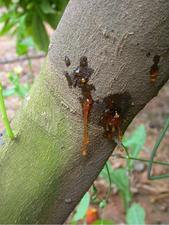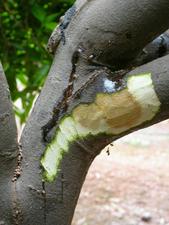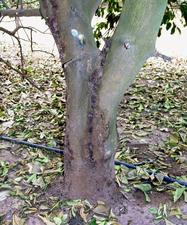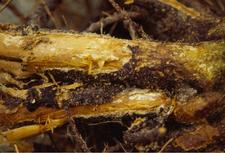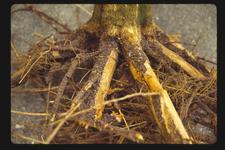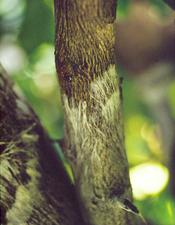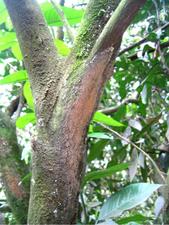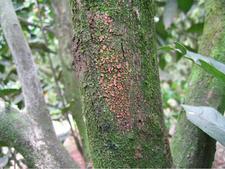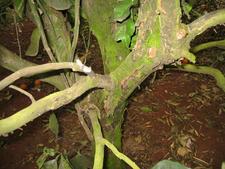Fungal Diseases of Citrus that Resemble Systemic, Graft-transmissible Diseases
PHYTOPHTHORA DISEASES
HISTORY, DISTRIBUTION, AND IMPORTANCE
Phytophthora spp. causes some of the most economically important diseases of citrus worldwide. Losses occur in seedbeds from damping-off; in nurseries due to root or foot rot (gummosis and collar rot); in orchards due to foot rot, fibrous root rot, and brown rot of fruit in the field or after harvest in the packinghouse. These diseases are common in most citrus-producing areas and can be confused with diseases caused by systemic, graft-transmissible diseases. The discussion here will be limited to symptoms caused by root and trunk infections, since those are the symptoms that can be confused with systemic diseases.
Abbreviation: FD for Fungal Diseases
SYMPTOMS
The symptoms of root rot damage are a thinning of the canopy, failure to form vigorous new growth, and reduced yield. These symptoms result from deterioration of the fibrous root system and failure of the tree to replace roots rapidly enough to maintain tree health. The root cortex is lost and only the central stele remains on affected fibrous roots. Under favorable conditions, lateral roots may also develop frog-eye lesions. Rot of major roots can be greatly exacerbated by attacks of root weevils, such as Diaprepes abbreviatus, that damage the root cambium and facilitate infection. Declines due to rots of fibrous or major scaffold roots can be confused with a number of diseases such blight, tristeza decline, or viroid-induced diseases.
Gummosis, foot rot, or collar rot is characterized by gum exudation and death of the bark on the trunk, usually above the bud union (FD. 01, 02, 03, 04). Bark scaling may occur as with psorosis, but the bark is killed down to the wood. The affected area has damp, sometimes soft bark, with olive to brown or black-discolored wood underneath. Later the bark dries and cracks and the wood underneath hardens and dries (FD. 03, 04). The affected area is often surrounded by callus tissue. Affected trees may be partially or completely girdled and as a result, yellow vein chlorosis can occur (FD. 05). These types of symptoms can be confused with psorosis bark scaling, leprosis, or symptoms of some viroid diseases. Phytophthora infections usually occur at ground level, but can appear on the scaffold branches especially on highly susceptible species like lemons (FD. 06, 07, 08). Young trees may be seriously affected by the disease, but even older trees may be killed under favorable conditions (FD. 09).
CAUSAL AGENTS
Phytophthora citrophthora (R. E. Sm. and E. H. Sm. (Leonian)), P. palmivora (E. J. Butler) E. J. Butler, and P. nicotianae (B. de Hahn) cause root rot and gummosis. All species of Phytophthora that affect citrus can cause root rot as well as crown rot and gummosis. This disease is most commonly caused by P. citrophthora in winter rainfall areas. In humid, subtropical and tropical areas, it is often caused by P. nicotianae, and this species may be important in summer months in Mediterranean climates as well. P. palmivora and P. citrophthora produce abundant sporangia on the fruit surface that can be spread through the tree by wind-blown rain and can be important as brown rot pathogens on fruit. P. palmivora is also an important pathogen along with Diaprepes root weevils in causing root rot and decline of citrus in Florida.
EPIDEMIOLOGY
Phytophthora spp. survives unfavorable periods as chlamydospores or oospores in soil or in decaying roots. Chlamydospores germinate readily when moisture is present and quickly form sporangia. Infection is usually by zoospores that are released from sporangia when free moisture is abundant. Zoospores are attracted to wounds or to the region of elongation of root tips, where they encyst, germinate and penetrate. A wound is necessary for infection of suberized bark.
DIAGNOSIS
Gummosis caused by Phytophthora spp. can usually be differentiated from other trunk diseases based on symptoms. This pathogen kills the bark whereas bark death in diseases such as psorosis and Rio Grande gummosis is usually limited. Typically, Phytophthora infections consist of areas of dead barks and exposed wood surrounded by callus tissue (FD. 03). Gum production is usually more extensive with Phytophthora trunk infection (FD. 06) than with psorosis, but in humid areas the water-soluble gum is often washed away by rains. Most of the Phytophthora infection begins near the soil line, whereas other diseases show symptoms higher in the canopy.
Declines due to root rot caused by Phytophthora spp. are more difficult to identify since there are often no aboveground symptoms. It may be necessary to determine the soil populations of the pathogen using selective media. Nematode problems must also be eliminated as a potential cause and these problems can usually be diagnosed by soil sampling. Declines caused by tristeza usually occur only on trees on sour orange rootstock whereas Phytophthora root rot can occur on many rootstocks.
HOST RANGE
Sensitive, tolerant, and resistant species
Most of the common scion cultivars are susceptible to infection of the trunk and scaffold limbs by Phytophthora. Sweet oranges, lemons, limes and grapefruit are highly susceptible and tangerines and their hybrids are more tolerant. Within the sweet oranges, navels and early oranges are more susceptible than Valencias. Rootstocks vary greatly in the degree of susceptibility and may differ in their susceptibility to fibrous root and bark infection or to different species of Phytophthora. Trifoliate oranges and many of its hybrids, such as Carrizo and Troyer citranges and Swingle citrumelo, as well as sour orange and alemow are considered very resistant. Rangpur lime, Cleopatra mandarin, and many lines of rough lemon are more susceptible, but tolerate Phytophthora diseases under most soil conditions. Some rootstocks such as sour orange are very tolerant to bark infection, yet quite susceptible to fibrous root rot.
Management
Management strategies for foot and root rots and gummosis include improving soil drainage by disposal of surface water after heavy rain, installation of underground tile drains above impervious soil layers, improving irrigation practices, applying fungicides, or replanting with trees on a more tolerant rootstock. The grove should not be over-irrigated and mini-sprinkler irrigation systems, which accurately control water delivery, are recommended. Chemicals, such as copper-containing compounds, applied as sprays to the trunks and skirts of trees, metalaxyl delivered through the irrigation system or as a soil surface spray or drench, fosetyl-Al or phosphorous acid as a foliar spray, drench or trunk injection, can be used if registered for use on citrus in the production area. However, the most effective control for all species except P. palmivora is the use of resistant rootstocks such as those listed above.
CONTROL
Control of gummosis or collar rot requires additional measures, since the scion is usually more susceptible than the rootstock. The bud union must be kept well above soil through high budding and careful planting and care must be taken to keep soil away from the trunk. Mechanical damage to the trunk must be avoided since such wounds serve as infection points.
Phytophthora diseases can be controlled in nurseries by collecting seed only from fruit high in the canopy, or by hot water treatment (52°C for 10 min) or steam-air treatment (60°C for 30 min) of seed. Pathogen-free potting mixes and good nursery practices to avoid contamination of the mixes or nursery soils should be used. In field nurseries, soils may be fallowed or fumigated chemically to reduce populations of the pathogens.
ARMILLARIA ROOT ROT
HISTORY, DISTRIBUTION, AND IMPORTANCE
Armillaria root rot, also known as mushroom root rot and oak-root fungus, causes a decline of citrus trees that can be confused with declines caused by systemic, graft-transmissible pathogens. The basidiomycete fungi that cause this disease are widespread in native forests worldwide. Thus, the disease on citrus is usually associated with areas where forest trees have been removed recently.
SYMPTOMS
Decline produced by Armillaria root rot usually progresses slowly and the decline symptoms are initially mild over the entire canopy of the tree. The soil-borne fungi that cause this disease invade the scaffold roots causing decay of the larger roots (FD. 10). Once this decay has advanced to all of the major roots, trees may collapse suddenly (FD. 11). These symptoms may resemble those caused by tristeza quick decline. There are often lesions at the base of the trunk that can resemble those of Phytophthora crown rot.
CAUSAL AGENTS
The disease is caused by several species of the basidiomycete fungus Armillaria (syn. Clitocybe). The fungus may produce basidiocarps at the base of the trunk which are diagnositic for the disease. This pathogen produces basidiospores which are airborne and subsequently colonize exposed roots or branches on the soil surface. However, most of the disease spread is from tree to tree by rhizomorphs produced on rotting roots. Thus, affected trees often form a tight cluster in the grove that is characteristic of the disease. Mycelial fans produced beneath the bark on rotting roots are diagnostic for the disease.
CONTROL
The disease is very difficult to control. All fields to be planted to citrus should be thoroughly cultivated and any remaining large roots or branches removed prior to planting. Once the disease is established in a grove, affected trees must be removed along with all the roots and the soil fumigated. Then it must be thoroughly tilled for some time prior to planting. Deep trenches dug surrounding the affected area will prevent further spread of the disease.
PINK DISEASE
HISTORY, DISTRIBUTION, AND IMPORTANCE
Pink disease affects the branches and trunks of mature trees and produces necrosis, gumming and bark scaling. These symptoms can sometimes be confused with psorosis, leprosis, or Phytophthora gummosis. It is most prevalent in humid, tropical areas and occurs primarily on trees with dense canopies.
SYMPTOMS
Mycelial fans of the fungus can be seen growing on the outside of the bark under favorable conditions (FD. 12). Subsequently affected bark dies down to the wood and the bark begins to scale and flake off and the pathogen sporulates on the dead bark when temperatures and humidities are favorable (FD. 13, 14). After the bark dies, it may scale off and resemble psorosis symptoms, but in contrast to psorosis the bark is dead to the wood (FD. 15). Once the limb has been girdled, the entire branch dies and the disease is often first noted as a number of dead limbs scattered through the grove.
CAUSAL AGENTS
The disease is caused by the basidiomycete fungus, Erythricium salmonicolor (syn. Corticium salmonicolor). Basidiospores are produced directly on fungal encrustations on the affected branches. Those spores are airborne and can initiate the disease nearby.
CONTROL
Control of the disease is difficult. Dead branches must be removed and burned. Spraying with copper fungicides is also effective, but it is difficult to penetrate dense canopies with sprayers and also hard to apply fungicides often enough to maintain control. Pruning to thin the canopies can improve air circulation and reduce disease incidence.
SELECTED REFERENCES
Broadbent, P. (1981) Armillaria root rot of citrus in New South Wales, Australia. Proc. Int. Soc. Citricult. 1, 351-353.
Erwin, D.C., O.K. Ribeiro (1996) Phytophthora Diseases Worldwide. APS Press. The Amer. Phytopathol. Soc., St. Paul, MN, 562 pp.
Graham, J.H., J.A. Menge (1999) Root diseases. p. 126-135 In L.W. Timmer & L.W. Duncan, eds. Citrus Health Management. APS Press, Inc. St. Paul, MN.
Graham, J.H., J.A. Menge (2000) Phytophthora-induced diseases. p. 12-15 In L.W. Timmer, S.M. Garnsey, & J.H. Graham, eds. Compendium of Citrus Diseases. 2nd ed. APS Press, Inc. St. Paul, MN.
Graham, J.H., L.W. Timmer (1992) Phytophthora diseases of citrus. p. 250-269 In J. Kumar, H.S. Chaube, U.S. Singh, & A.N. Mukhopodhyay (eds.) Plant Diseases of International Importance. Vol. III. Diseases of Fruit Crops.Prentice-Hall, Englewood Cliffs, NJ.
Lutz, A., J. Menge. (1986) Citrus root health II: Phytophthora root rot. Citrograph 72, 33‑39.
Timmer, L.W. (2000) Pink disease and thread blight. p. 35 In L.W. Timmer, S.M. Garnsey, & J.H. Graham, eds. Compendium of Citrus Diseases. 2nd ed. APS Press, Inc. St. Paul, MN.
Timmer, L. W., S.M. Garnsey, P. Broadbent (2003) Diseases of Citrus. p. 163-195 In R.C. Ploetz, ed. Diseases of Tropical and Subtropical Crops. CABI Publishing. Wallingford, UK.
Whiteside, J.O. (2000) Mushroom root rot. p. 11 In L.W. Timmer, S.M. Garnsey, & J.H. Graham, eds. Compendium of Citrus Diseases. 2nd ed. APS Press, Inc. St. Paul, MN.
Prepared (2006) by L. W. Timmer and J. H. Graham
Department of Plant Pathology
University of Florida, IFAS
Citrus Research and Education Center
700 Experiment Station Road
Lake Alfred, FL 33850
(USA)
Click on any image to see it larger.
PHOTOS |
LEGENDS AND AUTHORS |
|---|---|
|
Phytophthora foot rot of sweet orange showing bark necrosis, slight gumming, and callusing (Florida). Photo by J. H. Graham. |
|
|
Sweet orange tree more than half girdled by a Phytophthora lesion at the base of the tree (Florida). Photo by J. H. Graham. |
|
|
Extensive Phytophthora foot rot lesion on a grapefruit tree showing bark death and tissue callusing. The budunion is beneath the soil line (Florida). Photo by J. H. Graham. |
|
|
Clementine mandarin tree killed by Phytophthora citrophthora. Bark above the budunion is dead while the bark of the Troyer citrange rootstocks is alive (Spain). Photo by A. Vicent. |
|
|
Yellow vein symptoms associated with girdling of a young tree by Phytophthora foot rot (Florida). Photo by J. H. Graham. |
|
|
Gummosis on the branch of a Clementine tangerine following recent infection by Phytophthora citrophthora (Spain). Photo by A. Vicent. |
|
|
Gummosis and branch canker on Clementine mandarin caused by Phytophthora citrophthora showing bark necrosis in the scraped area (Spain). Photo by A. Vicent. |
|
|
Trunk and branch canker on lemon showing gummosis and bark death caused by Phytophthora nicotianae (Argentina). Photo by J. H. Graham. |
|
|
Trees of Clementine mandarin killed by Phytophthora trunk and branch cankers (Spain). Photo by A. Vicent. |
|
|
Citrus roots killed by mushroom root rot. Note mycelial fan of the pathogen beneath the dead bark (Florida). Photo by J. H. Graham. |
|
|
Citrus tree killed by mushroom root rot (Florida). Photo by J. H. Graham. |
|
|
Mycelium of Erythricium salmonicolor, the cause of pink disease, growing externally on live bark of a sweet orange tree (Bolivia). Photo by L. W. Timmer. |
|
|
Dead bark on a mandarin tree affected by pink disease showing sporulation of Erythricium salmonicolor on the surface (Brazil). Photo by N. A. Peres. |
|
|
Close-up of dead bark of a mandarin tree affected by pink disease showing sporulation of Erythricium salmonicolor on the surface (Brazil). Photo by N. A. Peres. |
|
|
Death and sloughing of the bark of a mandarin tree affected by pink disease (Brazil). Photo by N. A. Peres. |

